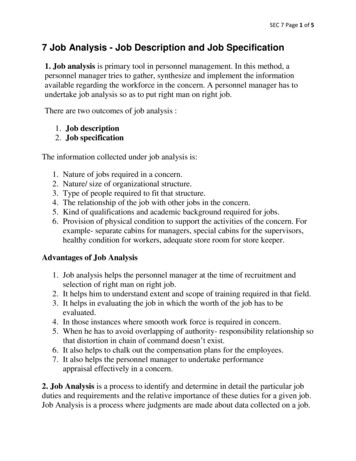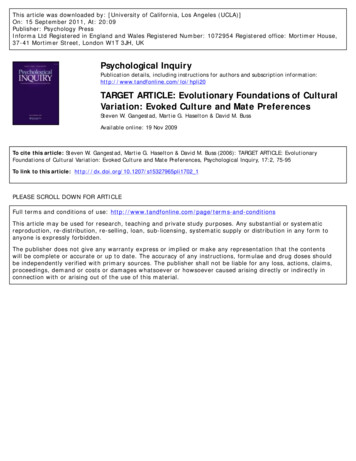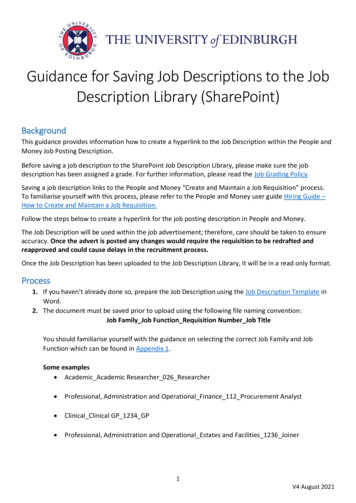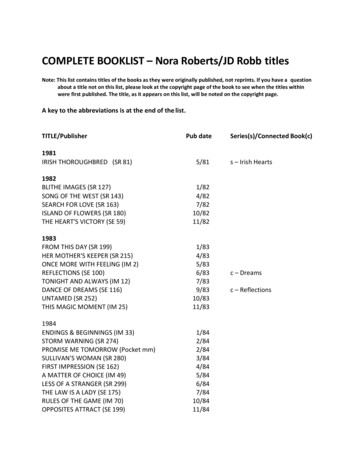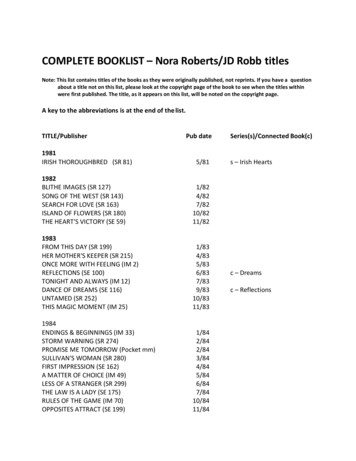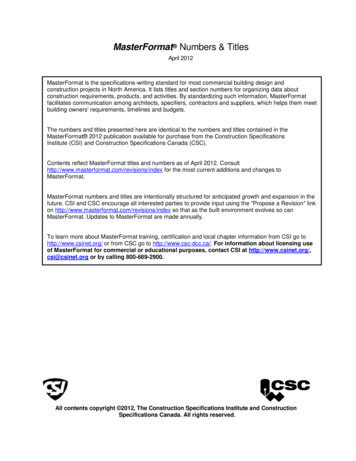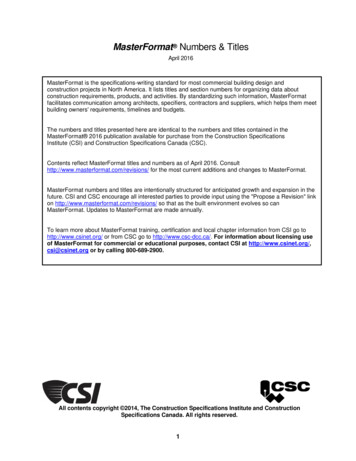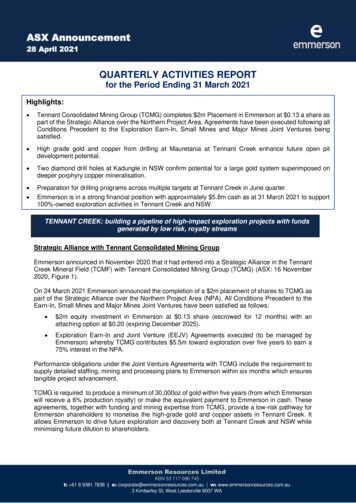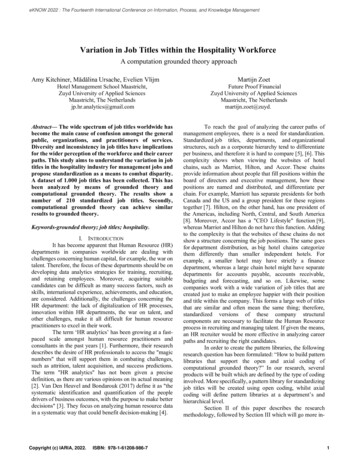
Transcription
eKNOW 2022 : The Fourteenth International Conference on Information, Process, and Knowledge ManagementVariation in Job Titles within the Hospitality WorkforceA computation grounded theory approachAmy Kitchiner, Mădălina Ursache, Evelien VlijmMartijn ZoetHotel Management School Maastricht,Zuyd University of Applied SciencesMaastricht, The Netherlandsjp.hr.analytics@gmail.comFuture Proof FinancialZuyd University of Applied SciencesMaastricht, The Netherlandsmartijn.zoet@zuyd.Abstract— The wide spectrum of job titles worldwide hasbecome the main cause of confusion amongst the generalpublic, organizations, and practitioners of services.Diversity and inconsistency in job titles have implicationsfor the wider perception of the workforce and their careerpaths. This study aims to understand the variation in jobtitles in the hospitality industry for management jobs andpropose standardization as a means to combat disparity.A dataset of 1.000 job titles has been collected. This hasbeen analyzed by means of grounded theory andcomputational grounded theory. The results show anumber of 210 standardized job titles. Secondly,computational grounded theory can achieve similarresults to grounded theory.To reach the goal of analyzing the career paths ofmanagement employees, there is a need for standardization.Standardized job titles, departments, and organizationalstructures, such as a corporate hierarchy tend to differentiateper business, and therefore it is hard to compare [5], [6]. Thiscomplexity shows when viewing the websites of hotelchains, such as Marriot, Hilton, and Accor. These chainsprovide information about people that fill positions within theboard of directors and executive management, how thesepositions are named and distributed, and differentiate perchain. For example, Marriott has separate presidents for bothCanada and the US and a group president for these regionstogether [7]. Hilton, on the other hand, has one president ofthe Americas, including North, Central, and South America[8]. Moreover, Accor has a "CEO Lifestyle" function [9],whereas Marriot and Hilton do not have this function. Addingto the complexity is that the websites of these chains do notshow a structure concerning the job positions. The same goesfor department distribution, as big hotel chains categorizethem differently than smaller independent hotels. Forexample, a smaller hotel may have strictly a financedepartment, whereas a large chain hotel might have separatedepartments for accounts payable, accounts receivable,budgeting and forecasting, and so on. Likewise, somecompanies work with a wide variation of job titles that arecreated just to make an employee happier with their positionand title within the company. This forms a large web of titlesthat are similar and often mean the same thing; therefore,standardized versions of these company structuralcomponents are necessary to facilitate the Human Resourceprocess in recruiting and managing talent. If given the means,an HR recruiter would be more effective in analyzing careerpaths and recruiting the right candidates.In order to create the pattern libraries, the followingresearch question has been formulated: “How to build patternlibraries that support the open and axial coding ofcomputational grounded theory?” In our research, severalproducts will be built which are defined by the type of codinginvolved. More specifically, a pattern library for standardizingjob titles will be created using open coding, whilst axialcoding will define pattern libraries at a department’s andhierarchical level.Section II of this paper describes the researchmethodology, followed by Section III which will go more in-Keywords-grounded theory; job titles; hospitality.I. INTRODUCTIONIt has become apparent that Human Resource (HR)departments in companies worldwide are dealing withchallenges concerning human capital, for example, the war ontalent. Therefore, the focus of these departments should be ondeveloping data analytics strategies for training, recruiting,and retaining employees. Moreover, acquiring suitablecandidates can be difficult as many success factors, such asskills, international experience, achievements, and education,are considered. Additionally, the challenges concerning theHR department: the lack of digitalization of HR processes,innovation within HR departments, the war on talent, andother challenges, make it all difficult for human resourcepractitioners to excel in their work.The term ‘HR analytics’ has been growing at a fastpaced scale amongst human resource practitioners andconsultants in the past years [1]. Furthermore, their researchdescribes the desire of HR professionals to access the "magicnumbers" that will support them in combating challenges,such as attrition, talent acquisition, and success predictions.The term "HR analytics" has not been given a precisedefinition, as there are various opinions on its actual meaning[2]. Van Den Heuvel and Bondarouk (2017) define it as "thesystematic identification and quantification of the peopledrivers of business outcomes, with the purpose to make betterdecisions" [3]. They focus on analyzing human resource datain a systematic way that could benefit decision-making [4].Copyright (c) IARIA, 2022.ISBN: 978-1-61208-986-71
eKNOW 2022 : The Fourteenth International Conference on Information, Process, and Knowledge Managementdepth about the data collection and analysis. In Section IV theresults of the open and axial coding are written. To continue,limitations can be found in Section V Ending with Section VIwhere it mentions further research and lastly theAcknowledgements are mentioned.II. RESEARCH METHODOLOGYThe goal of this research is twofold. The first goal isto identify similarities and dissimilarities in job titles acrossdifferent lodging enterprises with the objective to formulate aset of standardized job titles. In addition to the goal of theresearch, also, the maturity of the research field is a factor indetermining the appropriate research method and technique.With regards to job titles, this research field is mature. Anappropriate focus of research in mature research fields isformal hypothesis testing or reevaluating existingmethods[10]. Summarized, to accomplish our research goal, aresearch approach is needed in which job titles are identifiedand compared. To accomplish this goal, grounded theory isapplied. In total, three cycles of coding were followed: 1) opencoding, 2) axial coding and 3) selective coding [11].Figure 1. Computational Grounded Theory Model.The goal of open coding is to create the first level ofabstraction from analyzed data. This is realized by analyzingdata and merging found instantiations to high-level categories.Identifying more precise categories and relationships amongthe high-level categories is the goal of axial coding. In ourstudy, axial coding focused on identifying the standardizedjob titles. Selective coding was conducted to select the corecategory, relating categories and filling in categories that needfurther refinement[11]. In our research, this means thatstandardized job titles are appointed to departments andhierarchy levels. Then, to increase the generalizability 72round of automated coding through computational groundedtheory have been applied [12]. In Figure 1, the process isvisualized with the first step resulting in the creation of thepattern library for job titles. This step involves the explorationof text using unsupervised methods and manual coding.Following a chronological order, step 2 will result in thedevelopment of the departments and hierarchy which are inCopyright (c) IARIA, 2022.ISBN: 978-1-61208-986-7essence a cumulus of categories for the job titles. In this phase,guided deep reading facilitates the interpretation of patterns.This is because the researchers can evaluate their analysis ofthe patterns determined quantitatively in step 1. They candetect whether the patterns are interpreted in a meaningfulway and either confirm or reconsider initial patterns [12].These are also thoroughly analyzed through the means ofinter-rater reliability analysis and later translated into textwhich can be understood by the computer. Inter-raterreliability is a process in which coders/raters consistentlydistinguish between different items on a measurement scale,with the purpose of analyzing variations between ratings [13].After both steps have been completed, the testing phase hasstarted which creates rigorous and fully reproducible patternlibraries, measured by an F1 score. The process and results foreach stage of coding are discussed in the following section.III. DATA COLLECTION AND ANALYSISGrounded theory states that the first selection ofrespondents and documentation is based on the phenomenonstudied at a group of individuals, organizations, informationtechnology, or community that best represents thisphenomenon [14]. For the goal of this study, this means thejob titles managers use to describe their current job.Therefore, for this study, one real-life data set has beencollected from Hospitality.net, between the 1st of June andthe 15th of January 2021. The preprocessing of the datainvolved scraping the raw text descriptions into a .csv file. Inthis file, the information was sorted by date, job titles andgender, which supported creating the pattern libraries. Nofurther alterations were made, as the goal was to have the dataas raw as possible. The method of data collection involves apartially random stratified sampling for the entire populationof job postings of management employees, during the periodmentioned previously. This population, in the first phase ofour data collection, has been divided into different stratadepending on job title, level, company, and geographicallocation. For every strata, several job postings have beenscraped and analyzed, totalling 1652 job titles by opencoding. Starting from “date emails”, the sampling method hasbeen changed. The following phase involved letting thesystem scrape data and showing the results by means of anautomated generated email. The system would scrape newlyidentified job titles and mention the standardized version. Therole of the researchers was to check the accuracy of thesystem and to standardize new job titles if they were not yetin the system.First, the patterns with the largest N were added,with N being the number of words in a pattern. For example,the job title pattern “Finance and Accounting Director” hasan N of four with the label “Director of Finance”. At all times,there is at least one pattern guarantee to match a newlyidentified job title. If there is no match with a pattern, the jobtitle will be classified as a 999, which is always diverted tothe researchers who will either create or assign a label to it.2
eKNOW 2022 : The Fourteenth International Conference on Information, Process, and Knowledge ManagementA.Open CodingThe pattern library for the job titles was created firstas it served as a basis for the other two pattern libraries.Hereby the first layer in coding, open coding, was used. Inpractice, open coding is used to “organize similar words andphrases, concept-indicators, in broad initial thematicdomains” [15]. The coding scheme used was designed a prioriwhich was then translated into a code-book/business rulesthat were then used to hermeneutically categorize the text.Three primary researchers first manually coded the text,whereafter a fourth secondary researcher assessed the coding.The background of the primary researchers encompasses fouryears of a Bachelor's in Hospitality Industry, with the fourthresearcher having more than 10 years of experience in theindustry and a PhD in Business Informatics. After, an intercoder reliability score was measured. An example of one ofthe standardized job titles is ‘CEO', 'New company CEO,' and‘Chief executive Officer' which will be standardized into'Chief Executive Officer' as a job title. Once this score wassatisfactory, the coding of the job titles is translated intopatterns that are added into a named entity recognitionwhereafter the retrieved job titles are automatically coded. Ifa job title couldn’t be coded the system would notify the threecoders so that they could add coding to them. In addition, thecoders checked the automated codes to see if the systemcoded the proper elements.B.Axial codingGoing forward with the axial coding, the patternlibrary job title is being used as the basis of the other twopattern libraries: 1) Department and 2) Hierarchy. For theaxial coding, it has followed the same structure as the opencoding by first categorizing the standard job titles byhermeneutic skills and expert opinion, checking this by interrater analysis, and by coding it separately. For example,'Chief Executive Officer' is part of the administrativedepartment; ‘Finance Director’ is part of the financedepartment, and ‘Director of Human Resource’ is part of thehuman resource department. After completing this process,the axial coding has been automatized by creating the patternlibraries.IV. RESULTSThe application of the Computational Groundedtheory model has resulted in the creation of three patternlibraries. The precision and recall of these products aremeasured based on a calculated F1 score. Furthermore, thegradual development process is described in the followingsection.A.Pattern library for job titlesThe results of categorizing the job titles into apattern library are 210 standardized job titles. Moreover,inter-rater reliability has been applied to ensure rigorousresearch. This resulted in an inter-rater reliability score of83,0%. Furthermore, of the percentage of faulty coding,84.4% were incorrect due to variation in writing; for example,to label the job title ‘board of directors, one coder may writeCopyright (c) IARIA, 2022.ISBN: 978-1-61208-986-7‘member of the board of directors’, while another writes‘board of directors. On the other hand, 15,6% were moresignificant faults where titles were labeled entirelydifferently. An example of this would be labeling the pattern‘pastry chef’. Whereas one would label it as ‘chef de cuisine’,making it more general, another would keep it specific andlabel it as ‘pastry chef. After this process, more business ruleswere added, finalizing with 14 rules. Following this, an F1score was calculated to measure the precision and recall ofthe pattern library. The pattern library for job titles attained aperfect score of 100% after having been observed over 72times throughout the research.TABLE I. PRECISION MATRIXPositiveNegativePositive188 (TP)3 (FN)Negative47 (FP)48 (TN)Figure 2. Precision matrix line graphWhilst the patterns and corresponding labels were inthe server, daily e-mails were received, which containedabout zero to ten newly identified job titles per day and statedwhat label had been given to this title. The e-mail shows jobtitles that have been coded and job titles that have not beencoded. For those that had not been coded, new patterns werecreated. The job titles that were coded were checked againstthe classification of labeling. In Figure 2, the relative amountof job titles and the outcome of the classification of thelabeling is pictured on a timeline, followed by Table 1 whichshows the total of newly identified job titles after the patternlibrary has been created. As seen in the graph, the largestamount was true positives, followed by true negatives, falsepositives, and finally false negatives.B.Pattern library for departmentsThe results of the job title pattern library served as aninput for the creation of the department’s pattern library andtherefore, followed step 2 of Figure 1. During this phase, allthe standardized job titles have been categorized perdepartment. This resulted in a count of 17 departments for 210job titles. To define these departments, inter-rater reliabilityhas been applied by a total of 5 coders starting withconceptualizing a draft version of departments and developinga set of 9 business rules. These business rules have helped thecoders define mutually exclusive, qualitative, and completecategories which range from Administrative to Wellness andRecreation. The total number of categorized job titles intodepartments during inter-rater reliability is 100, representing10% of the data set at hand. For example, 'Chief ExecutiveOfficer' is part of the administrative department.3
eKNOW 2022 : The Fourteenth International Conference on Information, Process, and Knowledge ManagementAfter the manual process has been finalized, thepattern library has been tested through the means ofcomputation. From the 15th of October until the 15th ofJanuary, the pattern library is tested daily to validate thecompleteness and usefulness against newly identified jobtitles. If the pattern library cannot recognize what departmentto classify a standardized job title, the title will be added to thelibrary. This way, the pattern libraries will continuously bedeveloped. For this pattern library, the daily calculated F1score of the pattern libraries was 100%, meaning that theprecision and recall of the pattern library for standardizeddepartments is perfect. Like the job titles, the pattern and labelfile for the departments was updated when new patterns werediscovered. As this pattern library is based on the patternlibrary for job titles, the outcome of the positives/negativeswas the same.followed by the Area/Regional Executive Vice Presidents.This goes on till RO8. And Property-Based: PB1: GeneralManager, followed by the Assistant General Manager onPB2, Going on to the managerial level PB8.TABLE II. JOB TITLES OVERVIEW BY DEPARTMENTSDepartmentAdministrativeAsset ManagementBusiness Development StrategyCorporate AffairsCustomer ExperienceEngineeringEngineeringEventsFinance and AccountingFood and BeverageCount of Job Title23330135226921Human ResourcesInformation technologyOperationsRevenue ManagementRooms DivisionSales and marketingWellness and Recreation1071385293OtherGrand Total21210Pattern Libraries for hierarchyThe creation of the pattern library hierarchy resultedin three base hierarchy levels. As an organization can bedivided into head office (HQ), regional office (RO), andproperty-based (PB) job levels. Within the HQ level, 26patterns have been categorized. In RO there are 88 patternsand PB 97 patterns. This resulted in an organizationalstandardized structure, where “X” refers to the specific jobtitle or department, as for example “Director of Finance”. SeeFigures 3, 4 and 5.The hierarchy starts with Head Quarters and endswith Property-Based. As every organization is different it wasneeded to create more detailed levels to place job titles witha similar name in the same hierarchical level. The numbershows the level in the hierarchy, where one is the highest, andanything that follows is lower in ranking. The Chief FinancialOfficer, Chief Human Resource Officer, and ChiefSustainability Officer all come on the same level: HQ1.Followed with HQ2 the President and will go to HQ7. Thisexample explains the details of the standardized hierarchicallevels of the Head Quarters, there are also detailed levels forthe Regional Office: RO1 being the Group Directors,Figure 3. Property-Based Hierarchy LevelsC.Copyright (c) IARIA, 2022.ISBN: 978-1-61208-986-7Figure 4. Regional Office Hierarchy LevelsFigure 5. Headquarters Hierarchy Level4
eKNOW 2022 : The Fourteenth International Conference on Information, Process, and Knowledge ManagementFor this result, the researchers interviewed fourinternational experienced professors of Hotel ManagementSchool Maastricht to validate the hierarchical structurecreated. The insights given as a response were evaluatedbased on inter-rater reliability. The result was a score of 82%,meaning that 18% of the answers given amongst theprofessionals were different. For the 18% of the answers thatwere different a total of 7 business rules were created. Theresult of the F1 score of this pattern library also equaled100%, meaning that this Axial coding recognizes all theexisting patterns of the open coding.V. LIMITATIONSAs this paper has a global scope of analyzing jobtitles worldwide, it was more difficult to execute during thistime period, therefore there were time constraints. Other thanthat, this research was executed as a cross-sectional study,meaning that longitudinal research is needed to find changesover time to identify trends and adjust this within the patterns.The third limitation is the human bias, due to culturalbackgrounds or other interpersonal factors of the researchersthat affect the study’s validity. This has been reduced becauseof the inter-rater results. The fourth and last limitation is thesampling technique used in this research. Hospitality.net hasbeen used as sample data that has to be representable for theentire population.VI. CONCLUSION AND FURTHER WORKThe application of data analytics, measures and,tools has facilitated the process of creating the patternlibraries and, it proves that digitalization in the hospitalityindustry can be a key tool for solving business problems.These findings provide a potential mechanism forfurther development in creating standardization for job titlesin the Hospitality industry, in order to combat disparity.Moreover, this paper draws attention to the gaps in theindustry, such as the lack of digitalization and innovation inthe Human Resources department. The next recommendedstep would be to compare the findings with similar initiativesin the industry, such as Esco. This enterprise classifies skills,competencies and occupations within the European Union’slabour market, which serves a similar scope to the researchproposed in his paper [16]. Furthermore, additional resourcescould be devoted to analyzing the impact certain variableshave on job title disparity, such as gender, education, skillsand background. On a practical level, the hospitality industrycould use all these findings to create a digital platform forbusinesses worldwide which can compare job titles bydepartment, hierarchy and additional variables as per userpreference.ACKNOWLEDGEMENTWe thank Armand Odekerken and Dennis Trotta fortheir supervision during this project. We thank Victor Houbenand Jannick Hendriks for their assistance during the project.We would also like to thank Eric Mantelaers for sharing hisexpertise and his guidance.Copyright (c) IARIA, 2022.ISBN: 978-1-61208-986-7REFERENCES[1] J. H. Marler and J. W. Boudreau, “An evidence-basedreview of HR Analytics,” The International Journalof Human Resource Management, vol. 28, no. 1, pp.3–26, 2017, doi: 10.1080/09585192.2016.1244699.[2] L. Bassi, “Raging Debates in HR Analytics,” HumanResource Management International Digest, vol. 20,no. 2, pp. 74–80, 2012.[3] S. van den Heuvel and T. Bondarouk, “‘The Rise (andFall?) of HR Analytics: The Future Application,Value, Structure, and System BPP.2016.10908ABSTRACT.[4] D. Ø. Madsen and K. Slåtten, “The Rise of HR Analytics:A Preliminary Exploration by Dag Øivind Madsen,Kåre Slåtten :: SSRN,” Global Conference onBusiness and Finance Proceedings, vol. 12, no. 1, pp.148–159, Jan. 2017, Accessed: Nov. 29, l3/papers.cfm?abstract id 2896602[5] C. v Barrett, S. John, and L. ii, “Job Titles and EducationRequirements of Registered Nurses in Primary Care:A Research Practicum,” Apr. 2021.[6] C. Barrett et al., “Job titles and education requirements ofregistered nurses in primary care: An internationaldocument analysis,” International Journal ofNursing Studies Advances, vol. 3, p. 100044, Nov.2021, doi: 10.1016/J.IJNSA.2021.100044.[7] Marriott, “Board of Directors Marriott d-of-directors(accessed Oct. 02, ir.hilton.com/corporategovernance/management (accessed Oct. 02, -comittee (accessed Oct. 02,2021).[10] A. C. Edmondson and S. E. Mcmanus, “MethodologicalFit in Management Field Research MonitorExecutive Development,” Academy of ManagementReview, vol. 32, no. 4, pp. 1155–1179, 2007.[11] J. M. Corbin and A. Strauss, “Grounded theory research:Procedures, canons, and evaluative criteria,”Qualitative Sociology 1990 13:1, vol. 13, no. 1, pp.3–21, Mar. 1990, doi: 10.1007/BF00988593.[12] L. K. Nelson, “Computational Grounded Theory: 77/0049124117729703, vol. 29703.[13] N. Gisev, J. S. Bell, and T. F. Chen, “Interrateragreement and interrater reliability: Key concepts,approaches, and applications,” Research in Social5
eKNOW 2022 : The Fourteenth International Conference on Information, Process, and Knowledge Managementand Administrative Pharmacy, vol. 9, no. 3. pp. 330–338, May 2013. doi: 10.1016/j.sapharm.2012.04.004.[14] B. Glaser, Theoretical sensitivity : advances in themethodology of grounded theory. 1978.[15] M. Williams and T. Moser, “The Art of Coding andThematic Exploration in Qualitative Research,”Copyright (c) IARIA, 2022.ISBN: 978-1-61208-986-7[16]International Management Review, vol. 15, no. 1,2019.ESCO, “Homepage.” https://esco.ec.europa.eu/en(accessed Jun. 06, 2022).6
Hotel Management School Maastricht, Zuyd University of Applied Sciences . Maastricht, The Netherlands . such as attrition, talent acquisition, and success predictions. The term "HR analytics" has not been given a precise definition, as there are various opinions on its actual meaning [2]. Van Den Heuvel and Bondarouk (2017) define it as "the .

